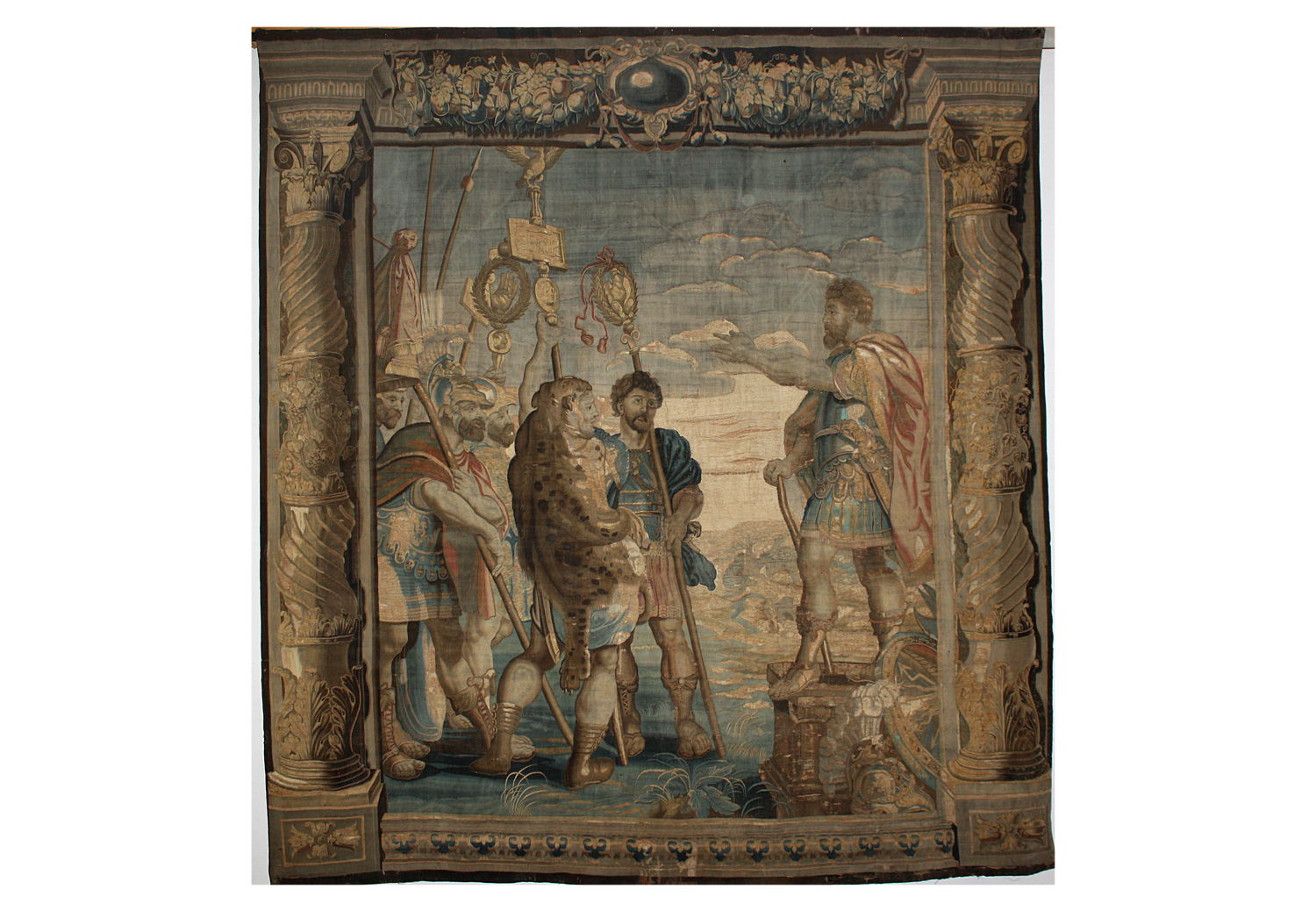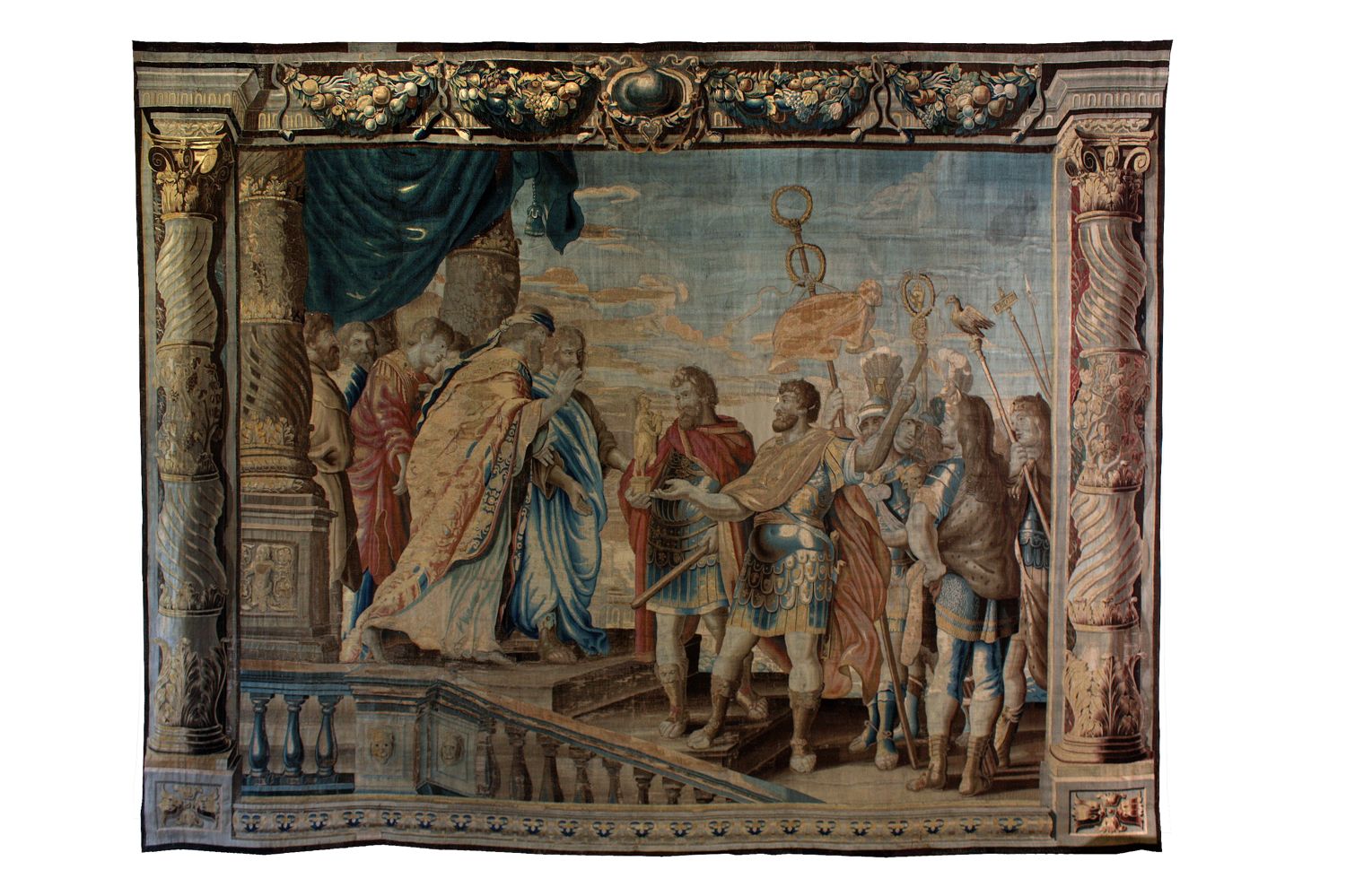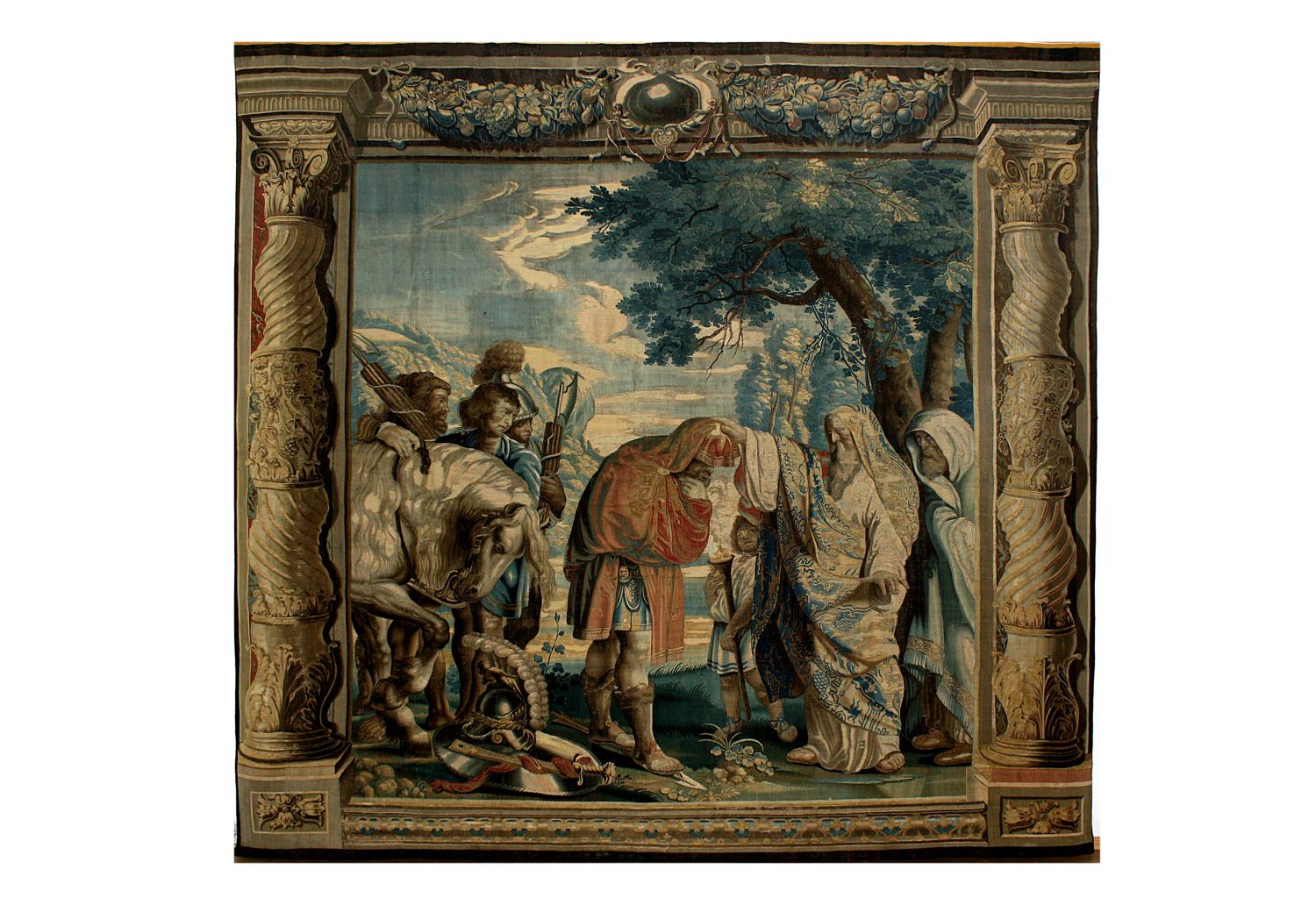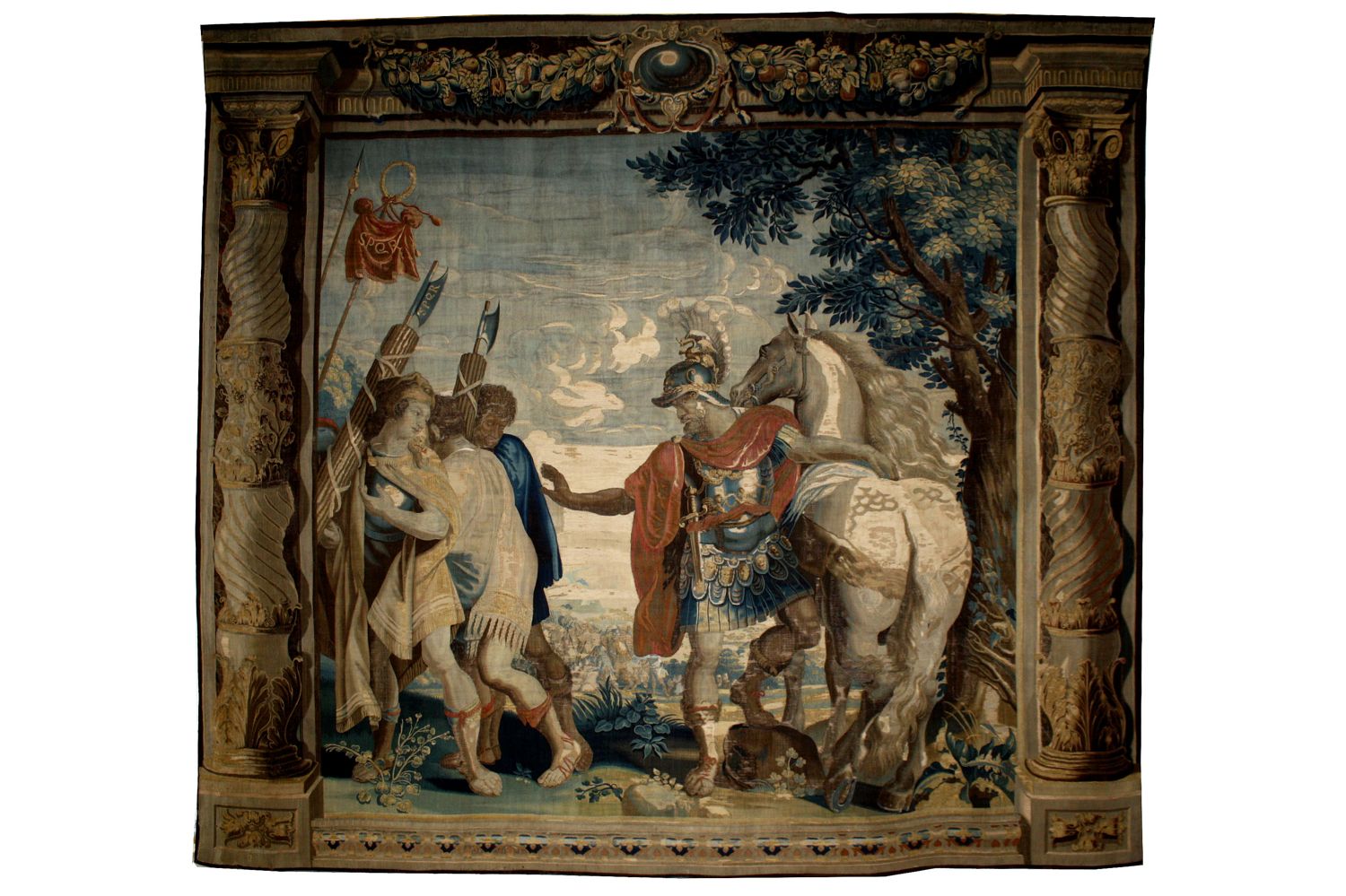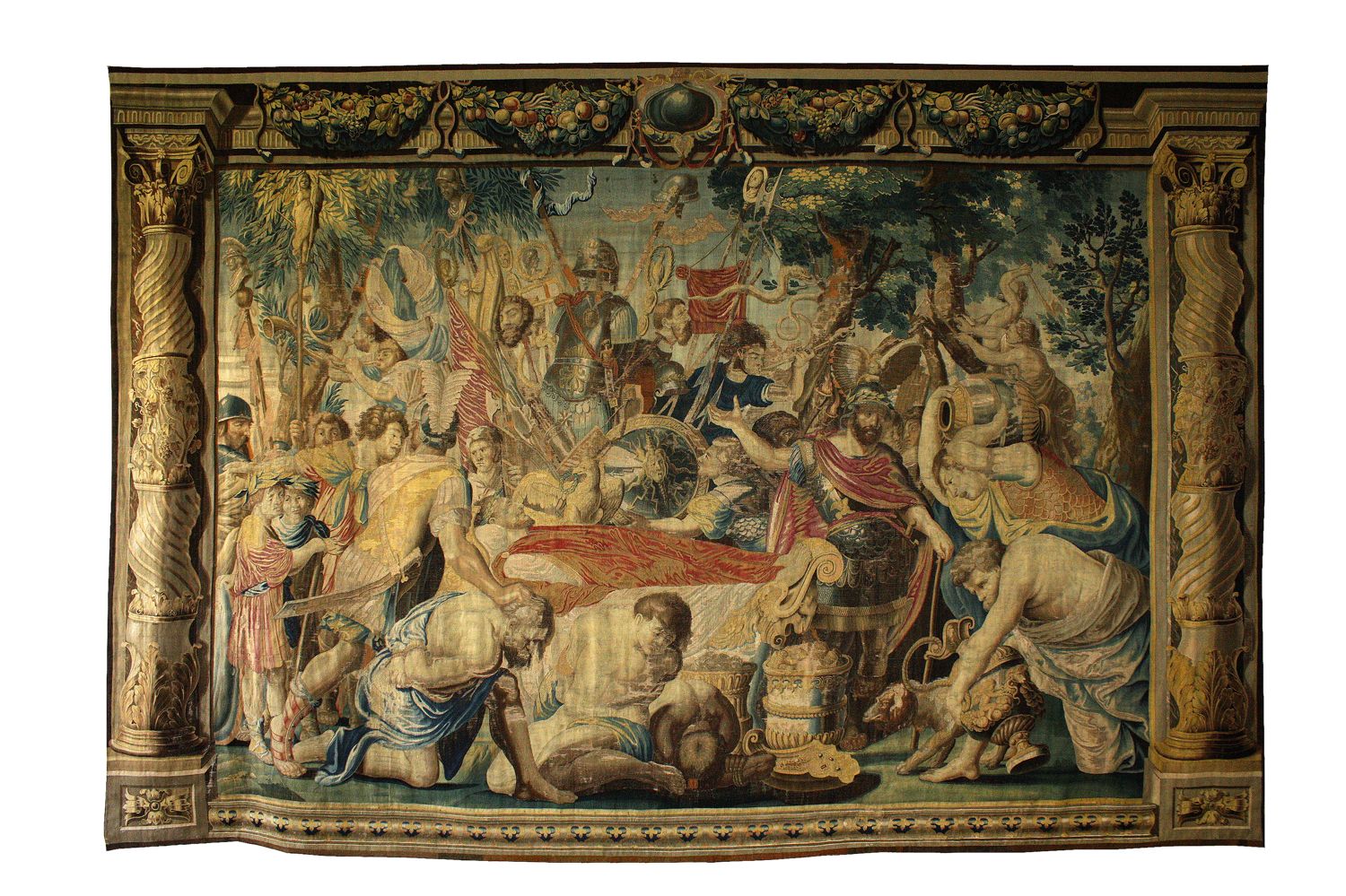Above: The Obsequies of Decius Mus 4.0m x 6.04m
Tapestries
The Decius Mus Tapestries are among the great glories of the wonderful historic Ormonde Collection at Kilkenny Castle. The ‘Decius’ suite had been in the ownership of the Ormonde family for over 300 years and was displayed in several of their residences before being acquired by OPW for display in Kilkenny Castle. The centuries took a toll on the delicate fabrics and major conservation was needed. This intricate work was entrusted to Real Fabrica de Tapices in Madrid, one of the leading international conservation specialists in this medium. After three years of painstaking work the Tapestries have returned to their ‘rightful home’ at Kilkenny Castle and again form a highlight of the Ormonde Collection in the Tapestry Room and fabulous Picture Gallery – one of the finest historic and architectural spaces in Ireland.
The Decius Mus Tapestries
Highly valued, tapestries were an important feature of the interior decoration of large houses in Europe during the 16th and 17th centuries and helped provide interior interest, warmth, and colour.
The Tapestries illustrate The Story of ‘Decius Mus’, a heroic tale of a Roman Consul who foretold his own death at the Battle of Veseris (Vesuvius) in the Latin War (340BC). These were designed in the early 17th century by the great Flemish artist Peter Paul Rubens and take the form of a ‘cycle’ or series narrating a story. Rubens composed the original artworks as ‘cartoons’ – designs which were followed by specialist weavers and transformed into tapestries. In this case the master craftsmanship was attributed to the workshop of Jan Raes in Brussels (though recent research is broadening our view). Several prized sets of the Rubens’ work still survive to-day, with a particularly splendid collection of original works taking pride-of-place in the Liechtenstein Museum in Vienna and further series in both the Swedish and Spanish Royal Collections.
The Decius Mus Tapestries (PDF)
The March of Decius Mus – Jane Fenlon. OPW Special Edition Irish Arts Review 2018 (PDF)
Decius Mus Relates His Dream
The night before battle, Decius Mus and Titus Manlius camped near Capua in the foothills of Mount Vesuvius. During the night Titus Manlius and Decius Mus both had the same dream; the army of the general who sacrificed himself to the Dii Manes and Earth, would be victorious. The following day Decius Mus made the noble decision to sacrifice himself for his homeland.
Decius Mus relating his dream; Decius standing on a pedestal at right and gesturing with his left arm while leaning on a stick, a group of standard-bearers standing in front of him, one wearing a leopard’s skin, the general’s helmet and shield resting against the pedestal in lower right; coat of arms below. The scene has been described as a commander addressing his legates and tribunes, from a position of height. It is thought that the scene is based on the adlocutio, a pictorial formula that was frequently used in Roman art.[1]
[1] Baumstark, Reinhold. Peter Paul Rubens: The Decius Mus Cycle
Decius Mus and Manlius Torquatus leave to fight the Latins
The consuls, who jointly led the Roman army against the Latins in 340 B.C. are represented in the first tapestry. Decius Mus wearing a red toga accepts from the pontifex maximus, or high priest, a statue of Mars holding in his hand a winged Victory, emblematic of the event of war. Titus Manlius stands to his left with his right arm outstretched and a weapon in his left. The farewell scene takes place on the steps of the senate building.
This scene does not exist in every series of Decius Mus; it exists in the Swedish Royal Collection, in both sets in Spanish Royal Collection and Hluoká Castle. Reverend James Graves (1815-86) clergyman, antiquary, and archaeologist published this traditional interpretation of this Ormonde tapestry in 1855. An alternative interpretation represents it as Titus Manlius presenting the Roman senators with plunder after the victory at Veseris, marking the end point of the series. The statue at the centre of the tapestry has also been alternatively named as Pallas Athena.
The Consecration of Decius Mus
The Death of Decius Mus foretold in a dream, sanctioned by the high priests of Rome, and accepted with noble dignity to save Rome, could not take place without ceremony. According to Livy Marcus Valerius is the high priest who performs the ceremony. Leaving his helmet, sword, and on the ground, Decius Mus wears a red toga (praetexta) that covers his lowered head; with his right hand he holds the hurriedly donned toga in place. Standing with both feet on a spear, he receives the last rites and recites the formulaic prayer known as the devotio:
“Janus, Jupiter, father Mars, Quirinus, Bellona, ye Lares, ye gods Novensiles… I devote the legions and auxiliaries of the enemy, together with myself, to the dii Manes and to Earth for the republic of the Quirites, for the army, legions, auxiliaries of the Roman people, the Quirites.”
Decius Mus and Marcus Valerius are the focus of the scene; the other figures in the scene are placed to each side. The high priest’s embroidered golden robe gleams as he reaches out and touches the bowed head of Decius Mus in the time-honoured gesture of blessing. A small child holding a torch indicates the ceremony took place at night. Waiting soldiers hold the hero’s warhorse that also bows his head.
Dismissal of the Lictors
Immediately proceeding the solemn rights, Livy writes that Decius Mus ordered his lictors to go to Titus Manlius and his fellow consul that he had commended himself to death on behalf of the army. Decius Mus’ stands out impressively against the background, his left foot firmly on the ground, dismissing the lictors with his left hand, his right hand already placed on his horse with his right foot poised to mount.
Their bowed heads indicate the lictors sorrow as they carry away Decius Mus’ emblems of office, the so-called fasces (bundles of rods tied around an axe). Then, Decius Mus fully armed, mounted his stallion wrapped in the toga he had slung over his shoulder, and charged into the enemy lines below. The ongoing battle scene is visible between the parting figures and shows where Decius Mus is going. The solemn ceremony took place in the heat of battle, as recounted by Livy.
The imposing figure of Decius Mus armed for battle appears to be based on the Roman statue of Mars Utor. The original from the temple of the same name in the Forum Augusteum in Rome is lost, but a Roman copy survives (Museo Capitolino, Rome). Decius Mus bears the same basic features of the head, the helmet, and armour type of that copy.
The Battle of Veseris (Vesuvius)
This Battle Scene depicts the climactic moment of Decius Mus’ story. Livy writes that Decius Mus presented a more majestic appearance than human, appearing as one sent from heaven bringing all the wrath of the gods on the enemy. When Decius Mus was mortally wounded in the neck with a lance, the enemy was thrown into panic, taking flight and left a gap in the lines. The Romans, under the command of Titus Manlius took advantage of the panic and defeated the Latins. Rubens introduced the lance as the weapon of death instead of arrows as in Livy’s history. The lance (hasta) was a long heavy spear, an ancient Roman national weapon, sacred to Mars, the god of war. Its use here provided Rubens with one weapon that would present the death of Decius Mus as one single dramatic act in the scene.
The death of Decius Mus is the central dramatic event of this scene. Decius Mus falls backward off his horse while his fingers cling onto its flowing mane. The hero’s horse rears up in a regal levade. Even as Decius Mus falls, another Latin warrior is raising his sword high to bring it down on the doomed hero. His imminent death is vividly expressed by sinking to the ground to join the corpses of the fallen. His transfigured gaze heavenward is seen as “exemplum doloris”, an object lesson in bearing pain heroically at the moment of death. The Latins are seen fleeing in the background.
The Obsequies of Decius Mus
Livy wrote that ‘night surprised them in their search’ and prevented the body of Decius Mus from being discovered until the next day among a pile of the slain enemy. Titus Manlius then arranged a solemn funeral. Decius Mus occupies the centre of the scene. He is the pivot of both the celebration and suffering. The dead hero wears a laurel wreath on his head and lies in state on a richly carved, gilded bier. Once again, as in previous scenes, in the narrative Decius Mus is distinguished by his red toga. Titus Manlius, Decius Mus’ co-consul, whom fate has spared, now appears to the right of the scene: his right hand held out encapsulating the scene, the corpse of Decius Mus, and a memorial of severed heads, captured weapons, standards and a suit of amour (tropaeum) being piled up as a sign of victory.
The scene is full of activity. Soldiers cut down branches and wood for the cremation, tubas indicate music in the background and precious booty in the form of gold, silver vessels and jewellery is being carried in. Roman soldiers handle and drag prisoners including women, and children into the foreground before the corpse of the hero.

